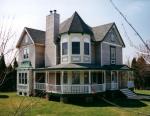Search engine visitors - click here to access entire "$ensible Home" web site
Click here to see a descriptive illustration of three unique modular houses.
Dear Jim: We are planning our dream home and we particularly want it to be efficient and secure. We thought about a luxurious modular home model which we saw at a home show, but is their overall quality very good? - Amol D.

A: The overall quality and efficiency of modular housing is often better than typical stick-built homes. Once a modular house is completed on your building site, it is virtually impossible to distinguish from a stick-built house. The range of styles and amenities is nearly endless.
People often confuse modular housing with the general term "manufactured housing". Modular housing is just a small subset of manufactured housing. Manufactured housing usually refers to mobile homes and trailers which are towed to your site by a truck and are not built on a standard foundation.
In contrast, a modular house is basically a stick-built house which is built in large sections in a factory. The sections are delivered to your building site where they are attached together over a slab, crawl space or basement. Some of the standard models are as large as 6,000 square feet.
The fact that modular houses are built in a factory makes them energy efficient, strong and secure. The modules (rooms) must be built strong enough to withstand the stress of transportation on a truck. Some are so well-built and airtight, they include heat recovery fresh air ventilation.
Whereas a typical stick-built house is made with 2x4 wall studs on 16-inch centers or, at best, 2x6 studs on 24-inch centers, most modular houses use 2x6 wall studs on 16-inch centers. The 2x6 walls make them more rigid resulting in less settling and more airtightness over its life. The deeper wall studs also provide space for two extra inches of wall insulation (R-19.6).
Another advantage of being built in a factory is quality control. All of the wall, floor and ceiling components are sized and assembled in jigs and aligned with laser precision for exact dimensional and assembly control. You won't find some extra nails in one stud and too few in another.
The lumber used in a modular house has not laid outdoors in the weather around a building site so it is more dimensionally true. If you have ever been to an outdoor lumberyard and tried to find a straight stud, you will understand this very well. This results in less settling, nail pops, etc.
When selecting a modular house, compare building material and construction specifications among several manufacturers. You may be able to upgrade efficiency items such as windows, doors, furnaces, etc. All interior amenities, such as whirlpools, real oak cabinets, six panel doors, etc., are included.
Instant Download Update Bulletin No. 963 - list of 36 selected manufacturers of modular houses, areas they serve, seven different models exterior diagrams with floor plans layouts (from 800 sq. feet to 3,500 sq. ft.) and typical materials (windows, doors, insulation, cabinets, etc.) and construction specifications.
Dear Jim: My second refrigerator is in a utility room. It stays humid in there because of the laundry. I want to run a dehumidifier, but I think it might just fight with the refrigerator. Will this be a problem? - Don B.
A: The dehumidifier and the refrigerator should not compete with one another for the room air. The room air will be warmer with the dehumidifier running, so this may increase the amount of electricity the refrigerator uses.
Since you have the refrigerator in the laundry area, make sure to clean the condenser coils often. With the lint in the air from the clothing, the refrigerator coils may get clogged with it.